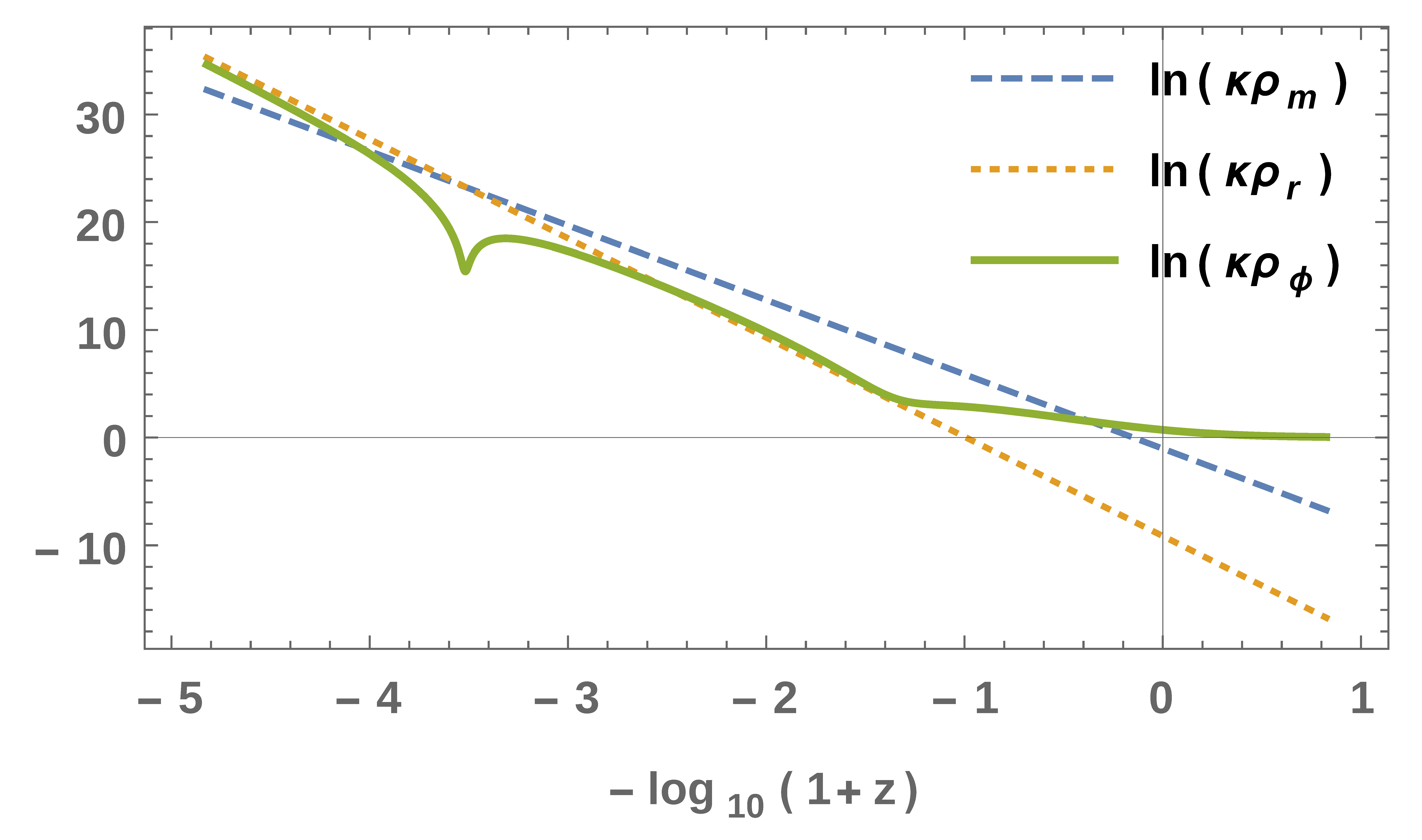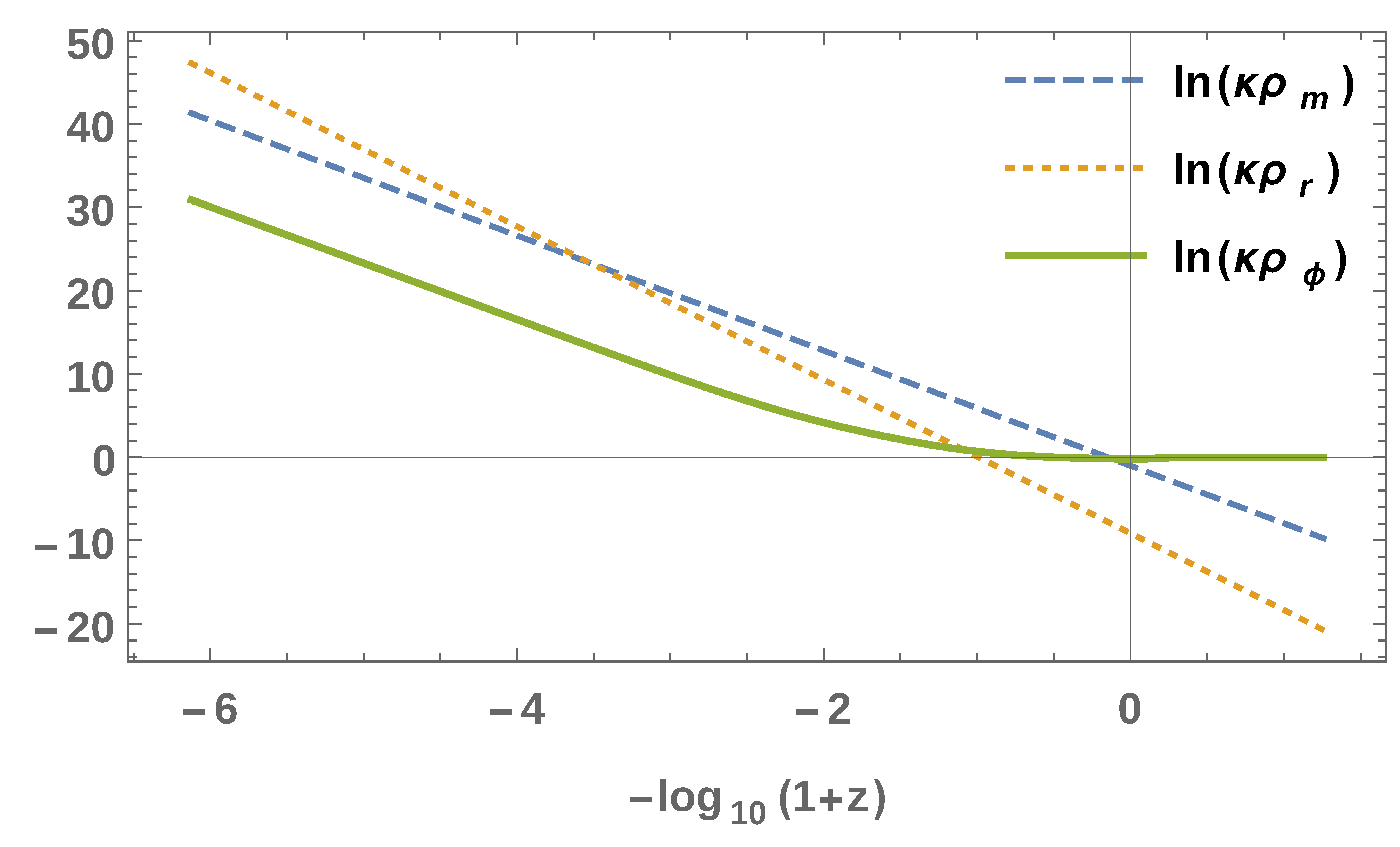A Review on the Cosmology of the de Sitter Horndeski Models
Abstract
:1. Introduction
1.1. Dynamical Screening
- At the critical point, the field equation must be trivially satisfied such that the value of the scalar field is free to screen. This means that, up to a total derivative, at the critical point the Lagrangian density must be independent of both andThis immediately shows that is at most linear in .
- In order to compensate for possible discontinuities of the cosmological constant appearing on the right hand side of the Friedmann equation, this equation must depend on once screening has taken place. In other words, . Taking into account Equation (4) and given that , as we saw above, it leads to
- Requiring a non-trivial cosmology before screening implies that the scalar field equation of motion must depend on . This leads to the same condition (6) if . In other words, for at least one value of i.
1.2. The de Sitter Critical Point:
2. Linear Models “the Magnificent Seven”
2.1. Only
2.2. Only a , Pair
2.3. Only a , Pair
2.4. Term-by-Term Model
2.5. Tripod Model
3. Non-Linear Models
3.1. Is the Dominant Contribution
3.2. Is the Dominant Contribution
3.3. and Are the Sole Contributions
3.4. Extension with , and
4. Summary
Acknowledgments
Conflicts of Interest
References
- Woodard, R.P. Avoiding dark energy with 1/r modifications of gravity. Lect. Notes Phys. 2007, 720, 403–433. [Google Scholar]
- Horndeski, G.W. Second-order scalar-tensor field equations in a four-dimensional space. Int. J. Theor. Phys. 1974, 10, 363–384. [Google Scholar] [CrossRef]
- Deffayet, C.; Gao, X.; Steer, D.A.; Zahariade, G. From k-essence to generalised Galileons. Phys. Rev. D 2011, 84, 064039. [Google Scholar] [CrossRef]
- Deffayet, C.; Esposito-Farese, G.; Vikman, A. Covariant Galileon. Phys. Rev. D 2009, 79, 084003. [Google Scholar] [CrossRef]
- Nicolis, A.; Rattazzi, R.; Trincherini, E. The Galileon as a local modification of gravity. Phys. Rev. D 2009, 79, 064036. [Google Scholar] [CrossRef]
- Weinberg, S. The Cosmological Constant Problem. Rev. Mod. Phys. 1989, 61, 1–23. [Google Scholar] [CrossRef]
- Carroll, S.M. The Cosmological constant. Living Rev. Rel. 2001, 4, 1. [Google Scholar] [CrossRef] [PubMed]
- Kaloper, N.; Padilla, A. Vacuum Energy Sequestering: The Framework and Its Cosmological Consequences. Phys. Rev. D 2014, 90, 084023. [Google Scholar] [CrossRef]
- Charmousis, C.; Copeland, E.J.; Padilla, A.; Saffin, P.M. General second order scalar-tensor theory, self tuning, and the Fab Four. Phys. Rev. Lett. 2012, 108, 051101. [Google Scholar] [CrossRef] [PubMed]
- Charmousis, C.; Copeland, E.J.; Padilla, A.; Saffin, P.M. Self-tuning and the derivation of a class of scalar-tensor theories. Phys. Rev. D 2012, 85, 104040. [Google Scholar] [CrossRef]
- Martin-Moruno, P.; Nunes, N.J.; Lobo, F.S.N. Horndeski theories self-tuning to a de Sitter vacuum. Phys. Rev. D 2015, 91, 084029. [Google Scholar] [CrossRef]
- Martín-Moruno, P.; Nunes, N.J.; Lobo, F.S.N. Attracted to de Sitter: Cosmology of the linear Horndeski models. J. Cosmol. Astropart. Phys. 2015, 2015, 033. [Google Scholar] [CrossRef]
- Martin-Moruno, P.; Nunes, N.J. Accelerating universe as a result of an adjustment mechanism. Int. J. Mod. Phys. 2015, 24, 1544018. [Google Scholar] [CrossRef]
- Martin-Moruno, P.; Nunes, N.J. Attracted to de Sitter II: Cosmology of the shift-symmetric Horndeski models. J. Cosmol. Astropart. Phys. 2015, 2015, 056. [Google Scholar] [CrossRef]
- De Rham, C. Galileons in the Sky. Comptes Rendus Phys. 2012, 13, 666–681. [Google Scholar] [CrossRef]


© 2017 by the authors. Licensee MDPI, Basel, Switzerland. This article is an open access article distributed under the terms and conditions of the Creative Commons Attribution (CC BY) license (http://creativecommons.org/licenses/by/4.0/).
Share and Cite
Nunes, N.J.; Martín-Moruno, P.; Lobo, F.S.N. A Review on the Cosmology of the de Sitter Horndeski Models. Universe 2017, 3, 33. https://doi.org/10.3390/universe3020033
Nunes NJ, Martín-Moruno P, Lobo FSN. A Review on the Cosmology of the de Sitter Horndeski Models. Universe. 2017; 3(2):33. https://doi.org/10.3390/universe3020033
Chicago/Turabian StyleNunes, Nelson J., Prado Martín-Moruno, and Francisco S. N. Lobo. 2017. "A Review on the Cosmology of the de Sitter Horndeski Models" Universe 3, no. 2: 33. https://doi.org/10.3390/universe3020033






